Description
CHAPTER ONE
INTRODUCTION
1.1 BACKGROUND OF THE STUDY
This research is on Analysis of techniques of managing an environment and its sustainability. According to Lélé, S.M. (1991) in Sustainable development: a critical review’, World Development 19: p.607-621, Environmental sustainability has become increasingly important as we witness more extreme weather changes, global warming and environmental degradation. As the world population grew, the need for more resources also increased. In order to meet the increasing demand for these resources, more industrial activities also grew around the world. These increased industrial activities over the years did not consider the resulting environmental degradation such as water, air and land pollution. The degradation was not considered along with the intended industrial growth, thus, the value proposition of much economic activity ignored these “costs”. Typically, the enterprises that produced these negative effects on the environment were not held accountable for them. They externalized these costs and the society suffered. Many ecosystems have been adversely affected to the point where they can no longer withstand or recover from natural disasters resulting from human activities and such disasters include global warming, flooding and extreme weather conditions.
These negative consequences on our environment have drawn a lot of attention on a global scale. Several nations have gathered over the years to deliberate on immediate solutions around the world. One of such conventions is the recent December 2009 summit that was held in Copenhagen, Denmark. The United Nations Framework Convention on Climate Change (UNFCCC) is the international environmental treaty produced at the United Nations Conference on Environment and Development (UNCED), informally known as the “Earth Summit”, held in Rio de Janeiro from 3rd to 14th June 1992.
The objective of the treaty is to stabilize greenhouse gas concentrations in the atmosphere at a level that would prevent dangerous anthropogenic interference with the climate. Subsequently, other conventions followed such as the Kyoto, Japan in 1997 and then the Copenhagen, Denmark in 2009. The issue of climate change was extensively discussed which has become a growing concern around the world due to carbon emissions from fossil fuels. Several countries such as Finland, Sweden and Norway to mention a few, have adopted some environmental policies to help reduce environmental degradation. Some of these policies have been challenged as detrimental to economic growth while others argued for more stringent environmental protection policies. Considering every country’s need to strive towards economic growth while sustaining the environment, there is the growing concern to adopt policies that give the right balance on both.
According to Barton, H. (2000), the environmental sanitation has become a prominent but complex and multi-dimensional issue on the public policy agenda of states and international organizations. This transformation after a long period of benign neglect began in Rio in 1992. The issue of the environmental sanitation is today perceived not simply as a narrow ecological problem of how to ensure a symbiotic inter-face between man and the environment. Its inner core has psychological, political, developmental, sociological and scientific ramifications, all of which are anchored to the new concept.
As the 2015 target date is being approached for the Millennium development Goals (MDGs), WHO and UNICEF are monitoring and addressing the current challenges and those that lie ahead. The United Nations Economic Commission for Africa (UNECA) latest update on Africa’s progress in achieving the Millennium Development Goals (MDGs) reports that, Africa is making some progress on MDG 7, which is to ensure environmental sustainability, Adams, W.M. (2001). Green Development: environment and sustainability in the Third World. London: Routledge.
Currently, Nigeria is part of the countries whose sanitation coverage rates are between 20% and 40 % points below the MDG targets. Even though, effort has been made by government agencies, local organizations to increase access to sustainable sanitation in major cities in Nigeria; by supporting the provision of improved sanitation facilities in schools and rural communities thereby contributing to the achievement of the national target of 90% by 2015 and 100% by large numbers of both urban and rural areas still lack access to adequate sanitary facilities like latrines, hand washing facilities and waste disposal facilities.
Non- availability of sustained, effective and safe services is common experience for many developing countries around the world and has resulted into a high prevalence of sanitation related diseases, causing many people; children in particular, to fall ill or even die. The standard of sanitation facilities reflects the socio-economic development of a nation.
The purpose of my thesis is to analyze the various environmental policies adopted by a number of developed and developing countries and the implication of these policies on the society. Also, I would explore the importance of balancing the scale between environmental and economic sustainability by bringing out successful policies adopted by some practicing countries. The format of this thesis is outlined in five chapters, each covering distinct areas as I work towards the conclusion of my analysis. Chapter 1 serves as the introduction to my paper. It gives an insight on what the thesis hopes to achieve and what each chapter will be discussing. Chapter 2 explores the literature review of environmental sustainability and sustainable growth. It brings out interesting contributions and criticisms in the cause of solving the environmental degradation problems. Chapter 3 discusses the research methodology used for this study. Chapter 4 analyzes the data gotten. Chapter 5 reflects the summary of findings, conclusions and recommendations.
1.2 STATEMENT OF THE PROBLEM
Ethically, the beauty of any environment lies on its good sustainable condition. This is so because, when an environment is clean, the lives of the citizenry are not threatened by illness and diseases. Proper refuse disposal management involves the dumping of wastes (solid, liquid or gaseous) from our homes, industries and public outfits at a specific place or in government provided containers and the control and removal of refuse from places where they can cause hazards to a place where they are less hazardous to public health.
Eruwa metropolis as a case study of the research work presents a ghastly picture; the neglect of filled refuse bin in recent time has its effect on the inhabitants. Many areas around the homes are littered with domestic refuse sewage wastes which are toxic with negative impacts on our environment, land, water and air.
Indiscriminate refuse dump affects quality of water and air of which the people seem not to be aware. Public Educational Programmes that enlighten the public on the health implication of indiscriminate refuse dump are almost non-existent. Mass Media seem not to be doing enough to create awareness about implications of bad environmental sanitation. It was against this background that the researcher embarked on this research to appraise the public health awareness of health implications of indiscriminate refuse dump in the Eruwa Metropolis.
1.3 OBJECTIVES OF THE STUDY
The major objectives of the study is,
- To find out whether inhabitants of Eruwa are aware of the implications of poor environmental management in the community.
- To ascertain if the community posses an effective system of managing their environment
- To evaluate the level of efficiency in the control and management of environment and it’s sustainability in Eruwa
- To investigate whether the methods proffered by the government are adequately creating awareness about health implications of bad environmental conditions in Eruwa metropolis.
- To identify various ways the environmentalist/policy makers could help in changing human behavior and responses to environmental options that will promote environmental sanitation.
1.4 RESEARCH QUESTIONS
This study was designed to address the following questions
- Do the inhabitants of Eruwa metropolis aware of the implications of poor environmental management in the community?
- Do you agree that the community understudy poses an effective environmental management system?
- What is the level of efficiency of Eruwa metropolis rural environmental management and it’s sustainability in Eruwa?
- Are there any techniques proffered by government adequately creating awareness about health implications of bad environmental conditions in Eruwa metropolis?
- What ways could the environmentalist/policy makers help in changing human behaviours and responses to environmental options that will promote environmental sanitation?
1.5 SIGNIFICANCE OF THE STUDY
The collection of refuse is irregular and inefficient in Eruwa metropolis. Litter and refuse often accumulated along roads and places, creating breeding ground for mosquitoes, flies, cockroaches and rodents responsible for the spread of many diseases. Drains were choked with refuse and there is open burning of waste everywhere. The results reveal whether the public are aware of the health implications on indiscriminative refuse dump in the environment. It also shows why governmental efforts may not be enough in solving environmental problem and why individuals must be involved.
Government at all levels is involved in refuse disposal. Local, State and Federal governments each control a specific part of the process. Refuse disposal is generally seen as a municipal responsibility because of the landfill and recycling components. Though this obligation is more or less moral or attitudinal in outlook, but a clean environment will impact positively on Eruwa’s socio economic wellbeing of the citizens.
The information will go a long way in helping the teachers, environmental educators and health educators will also benefit from the study in such a way that it would help them to emphasize the link between good health and clean environment. A workable solid sanitation strategy for Eruwa metropolis becomes dependent on a long team strategy for all citizens.
1.6 SCOPE OF THE STUDY
The study is delimited to the techniques of managing an environment and its sustainability, the study intends to investigate the people’s inability to maintain a sanitarily clean environment and to emphasize the link between good health and clean environment. The study covers some known dirty areas and dumping sites like, which included: The Akolu hills, Oke-Ola dumping site, and some other vicinities around the community.
1.7 LIMITATION OF THE STUDY
- a) Financial constraint: Insufficient fund tends to impede the efficiency of the researcher in sourcing for the relevant materials, literature or information and in the process of data collection (internet, questionnaire and interview).
- b) Time constraint: The researcher will simultaneously engage in this study with other academic work. This consequently will cut down on the time devoted for the research work.
1.8 RESEARCH DESIGN
In this study, the survey research method was adopted as the specific approach in the study. Survey research was found to be most appropriate for this particular study. Survey research as a research technique is used to obtain data; it requires either interviewing the respondents or providing them with self administered questionnaire. The researcher chose this method because this study is based on the impacts of sanitation system in rural communities and also because the population of the study is large and heterogeneous to be observed directly. More so, this method is used because it is suitable for gathering vast array of data and it makes data arrangement and computation less cumbersome.
The research design is according to Mbachu (2005) a plan or strategy for conducting the research, the design deals primarily with the question to be asked, to whom, how and when. The objective of a proper research design is to obtain as much valid information as quick as possible. This follows the fact that according to Mbachu (2005:109) once the research problem has been adequately formulated to specify the type of information needed, the researcher must work out his research design, as a plan, the research design deals with such things as population of the study, sample size, instrumentation, strategies for data collection etc.
1.9 DEFINITION OF TERMS
- Waste: It is the leftovers, used products whether liquid or solid having no economic value or demand and which must be disposed.
- Waste management: It refers to the act to maintain acceptable environmental quality, sound public health and creation of aesthetic value.
- Environment: It refers to the total surroundings of humans that support life
- Environmental sanitation: This is an intervention to reduce people exposure to disease by providing a clean environment in which to live.
- Environmental health: It refers to the health implications of the interactions between individuals and their natural and built environment.

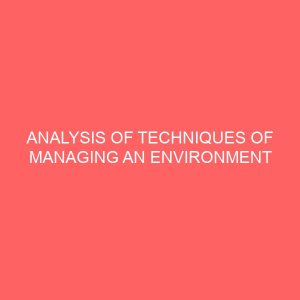
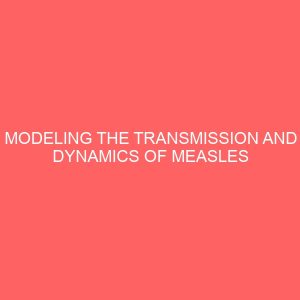


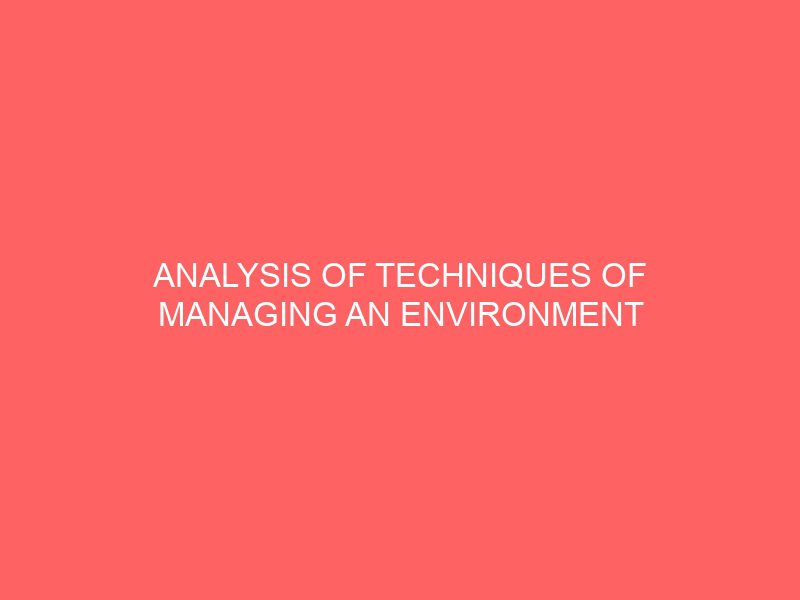
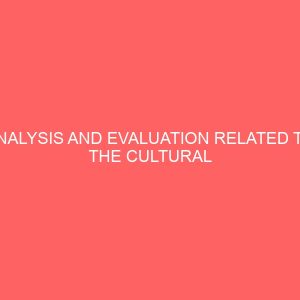
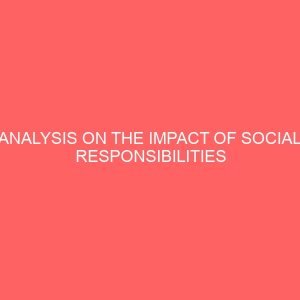
Reviews
There are no reviews yet.